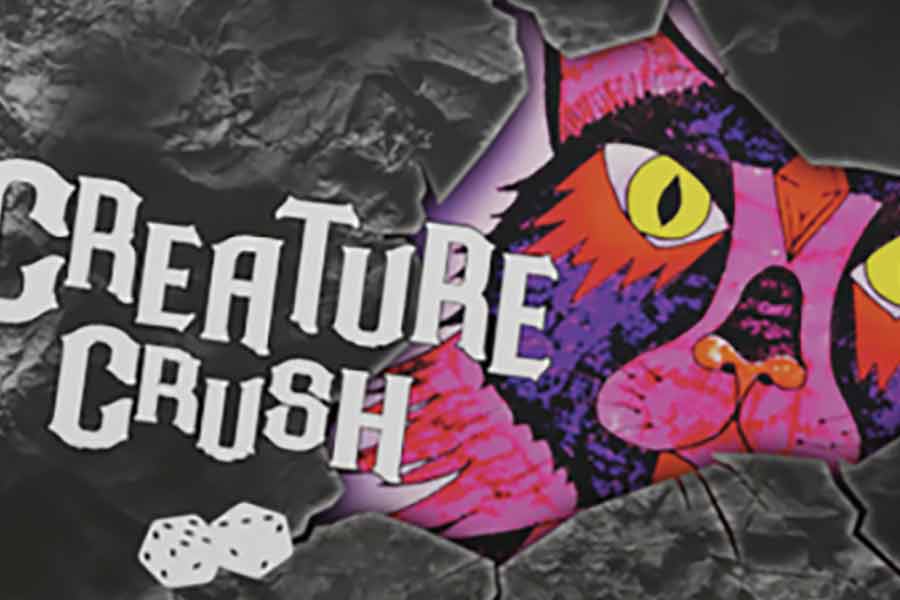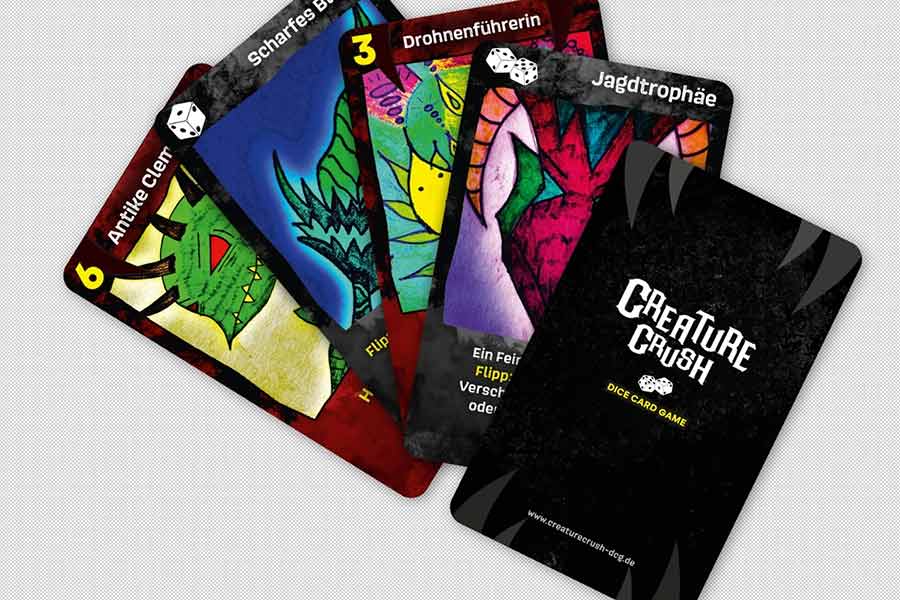Creature Crush is a trading card game or TCG (trading card game) for two people. And then not again. Because it’s actually (according to the creators) the first dice card game. It’s aimed at TCG fans and already contains many elements of those games. According to game designer Kilian Hawke, one of the most important differences is that the focus is not on collecting. The balance should not be changed repeatedly. But how do you play card, dice, and dueling games?
Trading card games as a genre
Probably one of the most famous TCGs The magic of gatheringwhich also includes deck building (besides Dominion) And he knew. TCGs often have licensed themes (eg Disney Locarna or Marvel Heroes: Card Game). Anyone who loves computer games can know this too Hearthstone. At its core, a TCG is defined by the fact that there are always new card packs and special cards that expand and change the game (often the balance mentioned above). Thanks to this collection component, all players have their own individual deck of cards, which only becomes powerful and exciting with booster packs. If you want to know more, you can read our review The magic of gathering (2002) or read the 2014 core collection.
Creature Crush as a Dice Card Game: A short overview of the game
In Creature Crush, we have life points equal to the number of cards in our deck. So when we discard cards, we lose life points.
The first player to run out of cards/life points loses the game.
We each have our own little playing field (battlefield) with three levels: A, B and C. There is room for six creatures (A and B) and three so-called crush cards (C), which can trigger a special action. On your turn, you can summon new creatures to your battlefield and/or attack using those displayed. We pay for both with dice (number of points). Like us, our creatures have life points and attack value as well. With this we can either attack the opponent’s cards or our opponent directly. The latter must then discard cards (i.e. life points). If a creature has no more life points, it is placed on the discard pile.
Additionally, creatures have effects that sometimes take effect immediately and sometimes in specific situations. We can use like cards if we have them. In the so-called Tactics phase, we are allowed to move creatures to other places (across levels). They both also cost dice (number of dice).
Dice Card Game: Luck of the dice in Creature Crush
It takes some time to get your bearings in Creature Crush. This is not least because of the instructions (more on that later), but the game also has a certain level of complexity. Experienced families and experienced players should get along well (questions about the rules aside), especially since Creature Crush has a high luck factor thanks to the dice.
If we want to summon or attack a creature, we have to pay the cost of the card using numbers. We have three starting dice available for this purpose, but more can only be achieved through card effects or if – with luck – we roll a pair of three dice. There are cards whose costs cannot be achieved with three dice. And: We have to not only achieve costs, but also exactly to reach. This little word makes it more difficult to be able to play the cards we want at the right time and limits the choice of cards each turn. We can have a board full of creatures and a hand full of cards and still not be able to play anything (or anything useful). Long-term strategy is only possible within a limited scope; Creature Crush thrives on tactical considerations.
Dice Card Game: Card Tactics in Creature Crush
However, when we summon a creature, we have to think carefully about where we place it and how we use it. We can postpone it for later, but only if our opponent has not defeated it by then. The line of attack is important: creatures can only attack cards facing each other (the game boards are facing each other and have three columns).
Creature effects are divided into keywords: “Revenge,” for example, means that this creature also deals damage when I attack it with one of my cards. Many creatures also have individual card texts, but unfortunately they are not always clear. For example, if the effect brings an additional starting dice when summoned. When exactly will we get it? Immediately? We have already rolled the dice (according to the instructions, this is a separate playing stage). In the next round? Or maybe permanently as long as the card is on the battlefield? Questions after questions…
Defense and attack
In addition to effects, we have to take into account attack rules, because not every level has the same range: creatures in the front row (A) can attack both opposing cards from row B and directly the other player – but only if there is no card in The attack line is in range B. Creatures in the second row (B) can only attack cards in the opponent’s areas A and B. Creatures in row B form the defensive line, while creatures in area A are there for direct attack.
It takes time to absorb that, especially in the first games, we had to look for it a lot. It would be desirable to have a general map here.
Deck building in Creature Crush
The discrepancy arises on the one hand because only some cards are played, and on the other hand because of the three variants of the game setup: in the entry level version we get a random deck, in the other two we create our own deck and the structure can thus be divided into: increasing complexity and by creating Your own deck Creature Crush plays more tactically: we can plan ahead when building the deck and know later roughly what to expect. Usually for this type, it is important to have suitable card decks.
In Creature Crush, it is important that there are not too many cards with the same value (costs) in the deck, otherwise achieving the correct numbers will be more difficult. High costs are especially difficult to achieve if they require more than three dice, so there shouldn’t be too many of them. Fewer numbers are not automatically easier: for a number that you have to roll explicitly with a die, it cannot be combined with several numbers. It’s all about balance. And of course to the luck of the dice later. Oh yeah, and don’t forget the Crush Cards…
Crush – Surprise!
They can sometimes spoil the other person’s plans. We initially play Crush cards face down and can use them later in the combat phase or in response to attacks (some have requirements that must be met first). A tactical element of surprise makes the game more dynamic.
However, it was not clear to us in the rules whether we have to use crush cards in the same turn without a prerequisite – especially since for some the costs are only specified when you enter them, but the purchase must be made before the crush card is actually played .
Editorial design and implementation
The small red dice are easy to treat as damage points for affected creatures and fit well into the game thematically and visually. Unfortunately, in many other places there is no similar editorial implementation. This concerns, among other things, not only the lack of overview cards and explanations of selected cards, but also the precise organization of how to deal with certain things. Some card text says “random,” but the instructions generally only state that this problem can be solved by drawing cards or rolling dice. Concrete implementation is left to the game round. Experienced players can pull this off well, but the feeling of a vague rule remains.
It is also unfortunate that you have to pay dice for face-up Crush cards, but the cost is not visible. This quickly creates a feeling of “what are you actually doing?” The way we solve it is that we cover the card and only show the top with the cost before running the card. Once you know the cards, this is also less than optimal because you can see the name of the card.
Formal defects
The instructions in particular, as well as some of the card text, are not convincing from a purely formal point of view. In addition to misspellings, there are sometimes half sentences without context. Proofreading (not to mention editing/editing) would have benefited the texts. You will also search in vain for a fingerprint (at least there is a fingerprint on the box, but no naming of the shareholders), and no age statement at all. The design is not pleasing to the eye, and not just because of the small font.
Design details like the title of the instructions as “Battle Plan” are nice, but unfortunately missing from the overall picture.
Instructions with room for interpretation
The content of the instructions is confusing. Some things aren’t where you expect them, so looking up usually means searching (so there’s no clearly labeled section at the end of the game, and information can be found under “Winning the Battle”). This makes it difficult to get started. However, the glossary, which is searchable for terms, should be positively mentioned.
The main problem is that the rules and card texts are not clear in many places.
In addition to the contradictions and open questions already mentioned, this concerns, for example, the beginning phase in which we draw cards and throw dice. The instructions say that we have to draw another card in addition to the four hand cards. This fits in with the beginning of the game, where we are given four cards in our hand when we prepare. However, in later rounds we have different numbers depending on how many cards we have played. Does this mean we always have to fill our hand cards up to five at the start of the round? Or just draw one card at a time, no matter how many cards we have? The only thing that helps is to try it out and identify something during the game round. It would have been very easy to solve with more precise wording.
In general, the game instructions leave a lot of room for interpretation. Some things only become clear to us when combined with card texts – and therefore only over the course of the game. Even if it is possible to fill in the gaps with house rules, you initially spend a lot of time researching and discussing the rules. As a result, the early games in particular are a bit bumpy.
Is Creature Crush a good game?
Creature Crush has a nice basic idea: a TCG that doesn’t rely on collecting (expensive) card packs, but is simply fun. Because it is precisely this point that definitely scares some game fans away from the genre.
Overall, Creature Crush unfortunately feels immature. In particular, the instructions, which are unclear in many places and the card texts are sometimes unclear, significantly reduce the enjoyment of the game and the attractiveness of replaying the game. that’s unfortunate.
Anyone who wants to participate in a game of dice cards, after several games of practice and perhaps discussion of the rules, will find a card game that has (editing) weaknesses but has interesting tactics. It will primarily appeal to TCG fans, but also to people who like the core TCG gameplay but don’t want to get involved in the collecting component. Maybe one day there will be a remaster of Creature Crush. It would be desirable.
Information about the Crash creature
- Title: Crush the Creature
- Publisher: DCG Creature Crush
- Author: Killian Hawke
- Number of players (from to): 2
- Duration in minutes: 20-40

“Explorer. Communicator. Music geek. Web buff. Social media nerd. Food fanatic.”









More Stories
Anya Taylor-Joy wears a sheer, spiky dress at the “Furiosa” premiere.
Astronauts on the moon can stay fit by running on the Wheel of Death
Cobra Kai season 6 will be divided into 3 parts, with the first part dropping in July